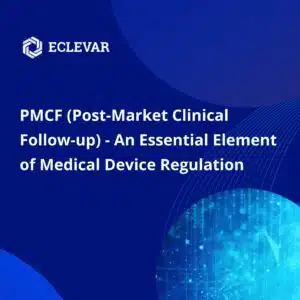What is the importance of PMCF (Post-Market Clinical Follow-up) as an essential element of medical device regulation?
Post-Market Clinical Follow-up (PMCF) is a crucial requirement procedure, that happens after CE marking, which consists of collecting real-life clinical data, to confirm the performance and safety claims of a medical device.
Among the clinical evaluation obligations, the medical product manufacturer must actively update the clinical data available so it can be possible to assess the benefit/risk ratio throughout the life of the product.
Keep reading and discover how PMCF studies are conducted, their objectives, and the benefits they bring to patients, healthcare professionals, and medical device manufacturers!
The purposes and design of a PMCF study
One of the recurring topics in the design of the PMCF is the long-term follow-up time in terms of safety and performance, which is rarely satisfactorily documented at the time of CE marking.
The updating of clinical data through the implementation of a post-marketing follow-up study has become a standard in the life cycle of the medical device. Manufacturers are required to offer numerous concurrent studies to a limited number of experienced investigators. The quality of the preparation and monitoring of these studies has become fundamental to their success, which is now highly strategic.
Several aspects of clinical data should be considered at the follow-up, including:
The systematic review of materiovigilance
Updating the bibliography:
- on the device itself
- on competitors
- on therapeutic alternatives.
Active collection of clinical data as part of clinical monitoring.
The purposes and design of the studies are quite variable depending on the medical devices and on the state of clinical knowledge. A device that is on the market for several years don’t follow the same clinical follow-up as an innovative product. The risk analysis and the state of scientific uncertainties must therefore guide the design of post-marketing clinical follow-up.
Clinical Follow-up studies require very regular monitoring, and frequent contact between the clinical project manager and each of the investigators. Ideally, quarterly or sometimes monthly data monitoring with telephone follow-up of each investigator, as well as an on-site visit by the project manager or sponsor once a year.
The number of subjects needed
In post-marketing monitoring, the main objective is to assess the safety of the device, so the number of subjects required is most often indexed to a hypothesis of the success rate of the intervention, for a duration of target follow-up with a confidence interval consistent with the data available in the scientific literature.
The key step in finding the right number is the critical evaluation of the literature, which makes it possible to set a hypothesis and an expected level of precision for the study of the clinical parameter.
Inclusion criteria
The inclusion criteria must lead to integrating into the study a representative sample of all patients who receive the device in real life under normal conditions of use.
We can therefore exclude patients who receive the device outside the indications provided in the instructions for use, but any other exclusion clause should be avoided, in order to be as representative as possible of the target population of the device.
Duration of the pmcf follow-up
According to the European Regulation on medical devices, post-marketing surveillance must update clinical data over the entire lifetime of the product. In theory, the target recoil of the study corresponds to the lifetime of the device studied, unless it is demonstrated that the potential incidents occur exclusively within a limited period after its use.
Choice of evaluation criteria
To update clinical data and confirm performance and safety claims, a follow-up may retain several evaluation criteria, such as:
- The success rate of an intervention
- The frequency of associated complications (clinical, biological, radiological, etc.)
- The functional scores associated with the devices and their evolution before and after the intervention
- Quality of life scores
Score is a questionnaire that, depending on the answers, establishes a quantified evaluation, either of the pathology, or of the anatomical function, or even of the life’s quality of a patient. To be accepted, the score must be validated in a specific study, in order to confirm its reproducibility, and the distribution of its values in the general population.
When should you set up a PMCF study?
All devices associated with a high risk for the patient, due to the characteristics of the device, the anatomical site of use (vital organs) or the risky medical condition of the patient, must be the subject to a Post-Market Clinical Follow-up.
The implementation is obligatory when:
- Available clinical data does not cover the lifetime of the device.
- The clinical data at the time of CE marking cannot be extrapolated to the entire target population due to more restrictive controlled clinical investigations.
- There are uncontrolled clinical risks in the analysis.
The regulatory status
There are 2 applicable frameworks:
- Either research involving the human person of category 3 (unintentional research in which all acts are performed in the usual way, without additional processing or monitoring procedures, but for when additional data collection is carried out).
- Studies based on existing databases in establishments where the sponsor retrospectively collects clinical data present in medical records.
Data analysis
Depending on the status of the device, the European Regulation requires the production of a periodic safety report every year or every 2 years. That way, it is necessary to plan a regular descriptive statistical analysis according to the required frequency, that studies the various evaluation criteria, and in particular, the frequencies of adverse events, and the functional results if necessary.
Purpose of PMCF Data Collection
The implementation of post-marketing follow-up studies has become a standard practice in the life cycle of medical devices, and manufacturers are required to conduct multiple studies with experienced investigators. To ensure the success of these studies, the quality of their preparation and monitoring has become crucial and strategically significant.
Several aspects of clinical data need to be considered during the follow-up process:
- Systematic reviews of materiovigilance, which involves monitoring and evaluating the safety and performance of the medical device
- The updating the bibliography, not only regarding the device itself but also in terms of competitors and therapeutic alternatives
- Active collection of clinical data as part of clinical monitoring
PMCF Data Collection Methods
Data collection methods can vary depending on the study design and objectives. One common approach is prospective data collection, where data is systematically collected over a predetermined period. This can involve follow-up visits, patient interviews, or remote monitoring to gather relevant information.
Another approach is retrospective data analysis, which involves reviewing existing data sources such as medical records or registries to provide valuable context and supplement prospective data collection efforts.
Combining these methods can offer a more comprehensive view of the device’s performance throughout its lifetime. By utilizing a variety of data collection methods, manufacturers can obtain a more profound understanding of the device’s performance.
The role of a Clinical Data Management (CDM) professional is crucial at this point. CDM is responsible for informing and statistically interpreting the collected data. Their expertise and involvement contribute to the overall success of PMCF studies by ensuring that the data collected is accurate, reliable, and suitable for analysis.
What ECLEVAR can do to your PMCF – Post-Market Clinical Follow-up
ECLEVAR can help in collecting the clinical data required and provide long-term clinical strategy that support your business in EU, UK and Australia.
Our team is led by former notified body and competent authority leadership that have significantly contributed to MDCG guidance documents on clinical evaluation, sufficient clinical evidence, and PMCF.
- Study population that represents the entire population indicated in the IFU;
- Does not involve experimental exposure;
- Aiming to cover the entire lifetime of the device;
- Is conducted at all types of clinical site, not just specialist units.
Ressources
– Guidance document Medical devices – Market surveillance – Post Market Clinical Follow-up studies – MEDDEV 2.12/2 rev.2
– MDCG 2020-13 Clinical evaluation assessment report template
– Regulation (EU) 2017/745 of the European parliament and of the council of 5 April 2017 on medical devices

